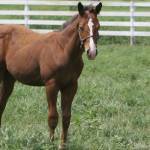Weaning Horses: Which Way Is Best?

Foals grow up with their dams always present, a constant source of protection, companionship, and milk. Weaning time comes when foals are about four to eight months old, and the separation can be quite stressful. Though most weanlings recover within a few days from the shock of being taken from their dams, it is not uncommon for these young horses to suffer a growth slump after they are weaned.
Weaning methods range from the “quick and clean” approach, where the foal is completely separated from the mare in one step, to various procedures in which the weaning is more gradual. Some farms take away a few mares each day, leaving the newly weaned foals in their familiar pasture with several mature horses still present. Others move the weanlings to a different location, placing them in an unfamiliar field with or without a “babysitter” gelding or barren mare for company.
Czech researchers recently made a comparison of two weaning techniques by investigating subsequent stress levels in foals. They measured growth rates and levels of salivary cortisol, an indication of stress, in 56 Kladruby weanlings at the national stud. At this facility, mares and nursing foals were kept in groups in large barns at night, and were turned out to pasture for six hours each day.
Foals were weaned when they were between 165 and 250 days of age, with the research being carried out over two breeding seasons. In one weaning method, prompt relocation (PR), weanlings were immediately moved to a new rearing property about three miles away from where they were separated by sex and allowed to mix with herdmates that had been previously weaned. In another method, step-wise relocation (SWR), some mares were removed while their foals stayed in the familiar location with other mares and unweaned foals. A week after weaning, the foals were moved to the rearing property.
Salivary cortisol levels rose after weaning in PR foals, indicating some acute stress. Salivary cortisol levels did not increase after weaning or relocation in the SWR foals compared to pre-weaning measurements.
To determine growth rates, the young horses were weighed regularly for 20 weeks after weaning. Results showed that growth rate significantly differed between the treatments, with SWR foals showing a significant growth slump during the three-week period after weaning. PR foals showed relatively stable increases in weight during the same period. When the weanlings were weighed five months later, the weight differences were still evident.
Based on these findings, the researchers suggested prompt relocation of weanlings, a procedure that increases immediate stress but does not result in weight loss and slowed growth. At Kentucky Equine Research, nutritionists recommend a feeding pattern that avoids sudden changes in the growth plane. Managers of foals, weanlings, and young horses should track weights on a frequent basis and adjust feeding schedules to achieve this goal.








